 This time, we’re going to visit the farm country of Pennsylvania, settled by German-speaking immigrants who formed a fairly cohesive community starting in the 1680s, as war convulsed their homeland. They comprised almost half of Pennsylvania’s population, and were supportive of the American Revolution, volunteering to serve in numbers even greater than the Congress asked for[i].
This time, we’re going to visit the farm country of Pennsylvania, settled by German-speaking immigrants who formed a fairly cohesive community starting in the 1680s, as war convulsed their homeland. They comprised almost half of Pennsylvania’s population, and were supportive of the American Revolution, volunteering to serve in numbers even greater than the Congress asked for[i].
The food they enjoyed was well-matched to their hardworking lifestyle, and is better enjoyed in our gentler age as a rare treat. Even so, they were noted at the time for being “remarkably stout and hardy men,”[ii] with above-average height likely stemming from their excellent nutrition in the relative wealth of the American Colonies.
We’ll be making two dishes – scrapple and shoo-fly pie – that are today closely identified with the Pennsylvania Dutch, although they may not yet have existed during the Revolutionary era. As William Woys Weaver notes in his delightful book Country Scrapple, “Recipes for scrapple are only useful to people who have not grown up on a farm where they would have seen it made firsthand.”[iii]
The earliest known recipe for scrapple was printed in 1856[iv], a full eighty years after the Declaration of Independence, yet it seems safe to say that the method outlined is probably not much changed in that time:

Other recipes (none printed until the 19th century, alas!) refer to scrapple as usually being prepared from a “small hog’s head,”[v] and note that it may also be prepared with an addition of pig’s blood and liver to make it more nourishing. These additions also hearken back to scrapple’s earlier roots, as a medieval pot pudding in Westphalia and northern Holland[vi].
However, blood had other commercial uses in the Colonies, and liver is often eaten on its own, not needing to be incorporated into another dish to be palatable. Scrapple is, in many ways, the bologna of its time, and is closely akin to modern-day sausage in its use as a means of ensuring that we waste as little as possible, eating “everything but the oink” of a slaughtered pig.
I’ll provide two different approaches to scrapple, one that attempts to stay as close as possible to the origins of the dish, and another that is significantly easier and less labor-intensive. Note: both recipes require that you prepare the scrapple the night before, so plan accordingly.
Colonial Scrapple
Place in a large cast-iron pot:
3 lbs(1.5 kg) pork neck bones, unsmoked ham hocks, or other fresh pork bones
Simmer over very low heat for two or three hours, until the meat falls off the bones.

Remove the meat from the broth and set it aside to cool. Skim the fat and foam off of the broth, and measure out four cups, reserving the remainder for future use. Pull the meat off the bones and mince or grind it.
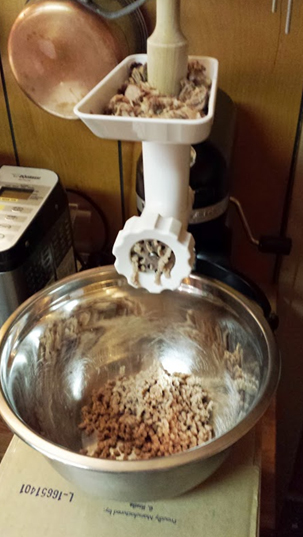
Return it to the broth, bring the mixture to the boil and add:
3 tsp (15 ml) rubbed sage
1 tsp (5 ml) black pepper
1 tsp (5 ml) salt
Add slowly, stirring constantly with a whisk:
1 1/4 cups(275 ml) cornmeal
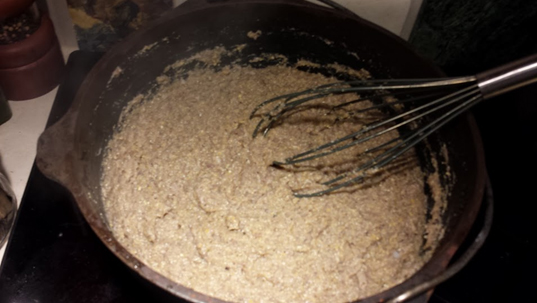
Continue stirring as it thickens. Remove from heat and spoon into small loaf pans lined with waxed paper.
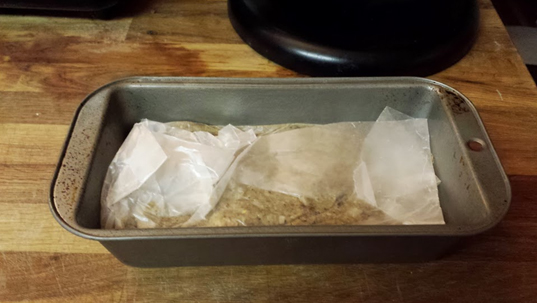
Refrigerate overnight.
To serve, remove the scrapple from the molds, and remove the waxed paper. Slice it into 1/2″ (1 cm) thick portions, dip in flour, and fry in a little bacon grease or butter, browning both sides.
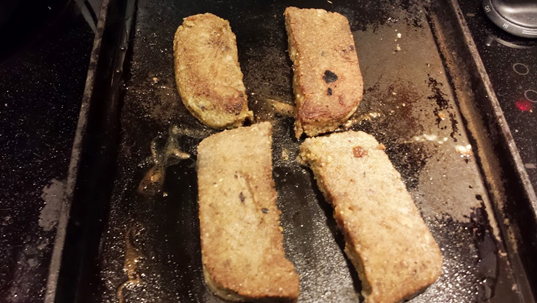
Serve warm, either with syrup (for breakfast) or with pepper relish or Tabasco (as dinner).
Modern Scrapple
If you can’t find pork necks, or don’t want to go through the fussy, messy work of picking the meat off the bones, you can still make a version of this old dish, without any exotic ingredients. The flavor isn’t quite as authentic to my palate, but it’s still a treat!
Bring to a boil:
3 3/4 c (650 ml) water or pork broth
1 tsp (5 ml) salt
1 lb (450 g) pork breakfast sausage (loose, not links or patties)
Make sure that the sausage breaks apart thoroughly, and once it’s cooked through, and the mixture is boiling briskly, slowly stir in:
1 cup (225 ml) cornmeal
Proceed as above, thickening, molding and serving as described.
Ragoo of Cauliflower
As we’re having the scrapple as a dinner meal, present-day sensibilities strongly suggest that we ought to have a vegetable with it. The inestimable Hannah Glasse provides a couple of different preparations for cauliflower, and the one reproduced below[vii] seems to be a fitting accompaniment to this meal.

Rinse in water and then cut into bite-sized pieces:
1 large head of cauliflower
In a large saucepan, melt together:
1/2 cup (225 ml) butter
2 tbsp (30 ml) water
Put the cauliflower in the butter mixture and toss to mix well. Sautée over low heat, shaking it periodically to ensure that all of the pieces cook evenly.

Once the cauliflower is tender, remove a few florets to use as garnish, then add:
2 tbsp (30 ml) flour
1/2 tsp (2 ml) black pepper
1/2 tsp (2 ml) salt
Toss to coat thoroughly, and then add:
1 cup chicken gravy
Continue to cook until the cauliflower is falling apart, and then serve, garnished with the reserved florets.
Shoo-Fly Pie
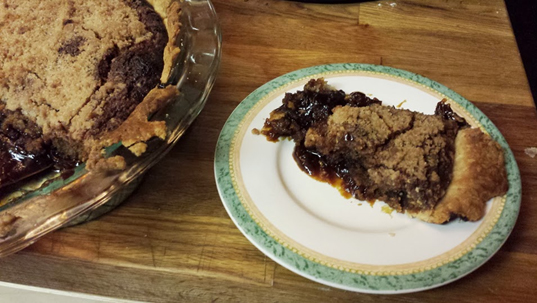
As briefly mentioned above, this is another recipe that’s closely associated with the old-style cooking of the Pennsylvania Dutch, but one which does not appear in the historical record until much later. It’s derived from the British treacle pie and later molasses cakes, but in his new book, As American as Shoofly Pie, William Woys Warner writes definitively, “Marketing claims notwithstanding: shoofly pie did not exist before the Civil War.”[viii]
Nonetheless, we’ll include it in this dish simply on the strength of its evocative place in Pennsylvania Dutch cuisine. This version of the pie is the one I grew up with, and is a transcription of a much-stained recipe card written in my grandmother’s hand. She had gotten the recipe from my great-grandmother, after marrying into the family with no experience of the dish herself. As a newlywed, when she asked her new mother-in-law how to make this childhood favorite of her husband’s, she was told to “just pour molasses in a pie shell.”
The resulting mess must have convinced someone to give her a more detailed recipe, which will still sometimes boil over in the oven – so it’s wise to put a pan or foil under it to make cleanup a bit easier.
Preheat the oven to 350° F (175° C). Prepare an unbaked pie shell. Blend together:
1 1/2 cups (375 ml) flour
1 cup (225 ml) sugar
1 tsp (5 ml) cinnamon
Cut in with pastry blender, or mix in a food processor, to make coarse crumbs:
1/4 cup (50 ml) butter
1/4 cup (50 ml) lard (substitute butter if you prefer)
Mix in a separate bowl:
1 cup (225 ml) boiling water
1 cup (225 ml) rich molasses
1 tbsp (15 ml) vinegar
Beat into mixture, prepared for bubbling and foaming:
1/2 tsp (3 ml) baking soda
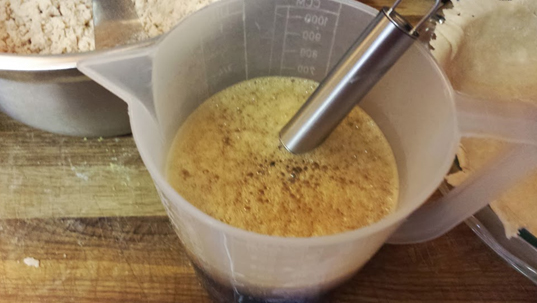
Pour the molasses mixture into the pie shell.
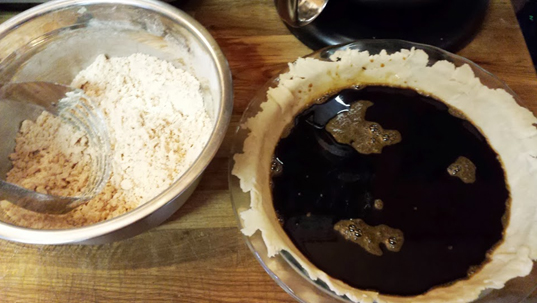
Spread the crumb topping over the molasses, forming a smooth surface of flour mixture floating on top of the liquid.

Carefully place in the oven and bake for about an hour, until a knife comes out clean, or at least close to clean. Serve cooled, in small wedges – this is a rich and strongly-flavored pie!
[i] Valuska, PhD, David L.. “Thompson’s Rifle Battalion.” The Continental Line. N.p., n.d. Web. 25 May 2013.
[ii] Thacher, James. Military Journal of the American Revolution. Hartford, Connecticut: Hurlburt, Williams & Co., 1862. 31. Print.
[iii] Weaver, William Woys. Country Scrapple. Mechanicsburg, Pennsylvania: Stackpole Books, 2003. 33. Print.
[iv] Bouvier Peterson, Hannah Mary. The National Cook Book. 9th. Philadelphia: Hayes & Zell, 1856. 57. Web.
[v] Johnson, Helen Louise. “Housekeepers Inquiries.” Table Talk Magazine. Jun 1894: 208. Web. 25 May. 2013.
[vi] Brown, Will. “Scrapple.” Ghotes of Virginia. N.p.. Web. 25 May 2013.
[vii] Glasse, Hannah. The art of cookery, made plain and easy. London: W. Strahan, J. and F. Rivington, J. Hinton, 1774. 111. Web.
[viii] Weaver, William Woys. As American as Shoofly Pie. Philadelphia, Pennsylvania: University of Pennsylvania Press, 2013. 256. Print.










6 Comments
My mother was of a Pennsylvania Dutch origin, so the scrapple (we called it “sousse meat”) and shoo-fly pie are quite familiar. (The first one to make a crack about my age gets a noogie.) I’ll have tp try the cauliflower.
Shoo Fly Pie is of course my favorite… I use blackstrap molasses exclusively in it. 😀
This is just the kind of thing that drives me nuts. Here we have “The Journal of the AMERICAN REVOLUTION,” and yet you’re discussing dishes that didn’t exist until MANY YEARS AFTER that event. Come on, really?! What, you couldn’t find any foods, dishes, or receipts (recipes) from the Revolutionary period?! Even for folks living in PA; like everyone else, they had to make do with what was available here. Regional differences were not that evident; it’s a much later element (golly, treacle? how British can you get?!). Maybe try one of these highly popular works of that time, Hannah Glasse’s The Art of Cookery Made Plain and Easy (1747)or E. Smith’s The Compleat Housewife (1727).
Hi, Carolina. I researched the books you mention, as well as many others, looking for documentary evidence for the development of scrapple, to no avail. As I mentioned, though, I am convinced that the dish existing during the Revolutionary Era in some form or another, and was only unrecorded because “everybody knows” how to make it.
I offer no excuses for including the shoo-fly pie; it is anachronistic to the Revolution, but typical of the region.
I disagree strongly, though, with your contention that there were not regional differences in diet and typical dishes; I find frequent contemporary references to such variations, and the contemporary sources that I can locate for recipes from different parts of the Colonies reflect the regional availability of ingredients, as well as local custom and fashion.
You may find other entries in this series more satisfying for your Revolutionary Era desires, and I look forward to your comments and feedback on them, as well.
I was raised on scrapple. My maternal grandmother made it whenever a hog was butchered, and she used to head and liver. Her recipe called for 1/3 pound pork liver to 2 pounds pork scrapes. She had me use neck and feet meat since I didn’t have a head available. She never used sage, but the rest of the recipe was the same as above. Since pork liver is hard to find, I go to a small butcher shop and have them save me some. I don’t know where the tradition came from for her, but her grandparents were from Prussia (1850) and the rest of her ancestors were Scotch/Irish. My father’s family never made scrapple, but both families made fried corn meal mush. Other than the Weilepps from Prussia, my family has been here since 1600s and early 1700s and I always assumed that the mush recipe came for that early time.
I buy the Scrapple from close butcher shops already bricked . the problem I have it melts out in the pan even if I flour it … what should I do ? I I have even blended in some chicken liver and hot sausage and ground it together . Don’t know what else to do to get a nice triangular piece of fried scrapple . just asking for some ideas